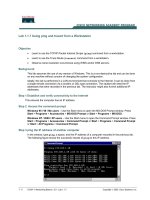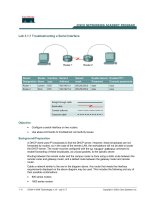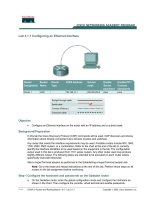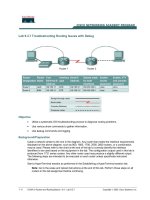Tài liệu Dive Into Python-Chapter 7. Regular Expressions doc
Bạn đang xem bản rút gọn của tài liệu. Xem và tải ngay bản đầy đủ của tài liệu tại đây (473.79 KB, 23 trang )
Chapter 7. Regular Expressions
Regular expressions are a powerful and standardized way of searching,
replacing, and parsing text with complex patterns of characters. If you've
used regular expressions in other languages (like Perl), the syntax will be
very familiar, and you get by just reading the summary of the re module to
get an overview of the available functions and their arguments.
7.1. Diving In
Strings have methods for searching (index, find, and count), replacing
(replace), and parsing (split), but they are limited to the simplest of
cases. The search methods look for a single, hard-coded substring, and they
are always case-sensitive. To do case-insensitive searches of a string s, you
must call s.lower() or s.upper() and make sure your search strings
are the appropriate case to match. The replace and split methods have
the same limitations.
If what you're trying to do can be accomplished with string functions, you
should use them. They're fast and simple and easy to read, and there's a lot to
be said for fast, simple, readable code. But if you find yourself using a lot of
different string functions with if statements to handle special cases, or if
you're combining them with split and join and list comprehensions in
weird unreadable ways, you may need to move up to regular expressions.
Although the regular expression syntax is tight and unlike normal code, the
result can end up being more readable than a hand-rolled solution that uses a
long chain of string functions. There are even ways of embedding comments
within regular expressions to make them practically self-documenting.
7.2. Case Study: Street Addresses
This series of examples was inspired by a real-life problem I had in my day
job several years ago, when I needed to scrub and standardize street
addresses exported from a legacy system before importing them into a newer
system. (See, I don't just make this stuff up; it's actually useful.) This
example shows how I approached the problem.
Example 7.1. Matching at the End of a String
>>> s = '100 NORTH MAIN ROAD'
>>> s.replace('ROAD', 'RD.')
'100 NORTH MAIN RD.'
>>> s = '100 NORTH BROAD ROAD'
>>> s.replace('ROAD', 'RD.')
'100 NORTH BRD. RD.'
>>> s[:-4] + s[-4:].replace('ROAD', 'RD.')
'100 NORTH BROAD RD.'
>>> import re
>>> re.sub('ROAD$', 'RD.', s)
'100 NORTH BROAD RD.'
My goal is to standardize a street address so that 'ROAD' is always
abbreviated as 'RD.'. At first glance, I thought this was simple enough
that I could just use the string method replace. After all, all the data
was already uppercase, so case mismatches would not be a problem. And
the search string, 'ROAD', was a constant. And in this deceptively simple
example, s.replace does indeed work.
Life, unfortunately, is full of counterexamples, and I quickly discovered
this one. The problem here is that 'ROAD' appears twice in the address,
once as part of the street name 'BROAD' and once as its own word. The
replace method sees these two occurrences and blindly replaces both of
them; meanwhile, I see my addresses getting destroyed.
To solve the problem of addresses with more than one 'ROAD' substring,
you could resort to something like this: only search and replace 'ROAD'
in the last four characters of the address (s[-4:]), and leave the string
alone (s[:-4]). But you can see that this is already getting unwieldy. For
example, the pattern is dependent on the length of the string you're
replacing (if you were replacing 'STREET' with 'ST.', you would
need to use s[:-6] and s[-6:].replace(...)). Would you like to
come back in six months and debug this? I know I wouldn't.
It's time to move up to regular expressions. In Python, all functionality
related to regular expressions is contained in the re module.
Take a look at the first parameter: 'ROAD$'. This is a simple regular
expression that matches 'ROAD' only when it occurs at the end of a
string. The $ means “end of the string”. (There is a corresponding
character, the caret ^, which means “beginning of the string”.)
Using the re.sub function, you search the string s for the regular
expression 'ROAD$' and replace it with 'RD.'. This matches the ROAD
at the end of the string s, but does not match the ROAD that's part of the
word BROAD, because that's in the middle of s.
Continuing with my story of scrubbing addresses, I soon discovered that the
previous example, matching 'ROAD' at the end of the address, was not
good enough, because not all addresses included a street designation at all;
some just ended with the street name. Most of the time, I got away with it,
but if the street name was 'BROAD', then the regular expression would
match 'ROAD' at the end of the string as part of the word 'BROAD', which
is not what I wanted.
Example 7.2. Matching Whole Words
>>> s = '100 BROAD'
>>> re.sub('ROAD$', 'RD.', s)
'100 BRD.'
>>> re.sub('\\bROAD$', 'RD.', s)
'100 BROAD'
>>> re.sub(r'\bROAD$', 'RD.', s)
'100 BROAD'
>>> s = '100 BROAD ROAD APT. 3'
>>> re.sub(r'\bROAD$', 'RD.', s)
'100 BROAD ROAD APT. 3'
>>> re.sub(r'\bROAD\b', 'RD.', s)
'100 BROAD RD. APT 3'
What I really wanted was to match 'ROAD' when it was at the end of the
string and it was its own whole word, not a part of some larger word. To
express this in a regular expression, you use \b, which means “a word
boundary must occur right here”. In Python, this is complicated by the fact
that the '\' character in a string must itself be escaped. This is sometimes
referred to as the backslash plague, and it is one reason why regular
expressions are easier in Perl than in Python. On the down side, Perl mixes
regular expressions with other syntax, so if you have a bug, it may be hard
to tell whether it's a bug in syntax or a bug in your regular expression.
To work around the backslash plague, you can use what is called a raw
string, by prefixing the string with the letter r. This tells Python that
nothing in this string should be escaped; '\t' is a tab character, but
r'\t' is really the backslash character \ followed by the letter t. I
recommend always using raw strings when dealing with regular
expressions; otherwise, things get too confusing too quickly (and regular
expressions get confusing quickly enough all by themselves).
*sigh* Unfortunately, I soon found more cases that contradicted my logic.
In this case, the street address contained the word 'ROAD' as a whole
word by itself, but it wasn't at the end, because the address had an
apartment number after the street designation. Because 'ROAD' isn't at
the very end of the string, it doesn't match, so the entire call to re.sub
ends up replacing nothing at all, and you get the original string back,
which is not what you want.
To solve this problem, I removed the $ character and added another \b.
Now the regular expression reads “match 'ROAD' when it's a whole word
by itself anywhere in the string,” whether at the end, the beginning, or
somewhere in the middle.
7.3. Case Study: Roman Numerals
You've most likely seen Roman numerals, even if you didn't recognize them.
You may have seen them in copyrights of old movies and television shows
(“Copyright MCMXLVI” instead of “Copyright 1946”), or on the dedication
walls of libraries or universities (“established MDCCCLXXXVIII” instead of
“established 1888”). You may also have seen them in outlines and
bibliographical references. It's a system of representing numbers that really
does date back to the ancient Roman empire (hence the name).
In Roman numerals, there are seven characters that are repeated and
combined in various ways to represent numbers.
I = 1
V = 5
X = 10
L = 50
C = 100
D = 500
M = 1000
The following are some general rules for constructing Roman numerals:
Characters are additive. I is 1, II is 2, and III is 3. VI is 6
(literally, “5 and 1”), VII is 7, and VIII is 8.
The tens characters (I, X, C, and M) can be repeated up to three times.
At 4, you need to subtract from the next highest fives character. You
can't represent 4 as IIII; instead, it is represented as IV (“1 less
than 5”). The number 40 is written as XL (10 less than 50), 41 as
XLI, 42 as XLII, 43 as XLIII, and then 44 as XLIV (10 less than
50, then 1 less than 5).
Similarly, at 9, you need to subtract from the next highest tens
character: 8 is VIII, but 9 is IX (1 less than 10), not VIIII (since
the I character can not be repeated four times). The number 90 is XC,
900 is CM.
The fives characters can not be repeated. The number 10 is always
represented as X, never as VV. The number 100 is always C, never
LL.
Roman numerals are always written highest to lowest, and read left to
right, so the order the of characters matters very much. DC is 600; CD
is a completely different number (400, 100 less than 500). CI is
101; IC is not even a valid Roman numeral (because you can't
subtract 1 directly from 100; you would need to write it as XCIX, for
10 less than 100, then 1 less than 10).
7.3.1. Checking for Thousands
What would it take to validate that an arbitrary string is a valid Roman
numeral? Let's take it one digit at a time. Since Roman numerals are always
written highest to lowest, let's start with the highest: the thousands place. For
numbers 1000 and higher, the thousands are represented by a series of M
characters.
Example 7.3. Checking for Thousands
>>> import re
>>> pattern = '^M?M?M?$'
>>> re.search(pattern, 'M')
<SRE_Match object at 0106FB58>
>>> re.search(pattern, 'MM')
<SRE_Match object at 0106C290>
>>> re.search(pattern, 'MMM')
<SRE_Match object at 0106AA38>
>>> re.search(pattern, 'MMMM')
>>> re.search(pattern, '')
<SRE_Match object at 0106F4A8>
This pattern has three parts:
^ to match what follows only at the beginning of the string. If this
were not specified, the pattern would match no matter where the M
characters were, which is not what you want. You want to make
sure that the M characters, if they're there, are at the beginning of the
string.
M? to optionally match a single M character. Since this is repeated
three times, you're matching anywhere from zero to three M
characters in a row.
$ to match what precedes only at the end of the string. When
combined with the ^ character at the beginning, this means that the
pattern must match the entire string, with no other characters before
or after the M characters.
The essence of the re module is the search function, that takes a
regular expression (pattern) and a string ('M') to try to match against
the regular expression. If a match is found, search returns an object
which has various methods to describe the match; if no match is found,
search returns None, the Python null value. All you care about at the
moment is whether the pattern matches, which you can tell by just looking
at the return value of search. 'M' matches this regular expression,
because the first optional M matches and the second and third optional M
characters are ignored.
'MM' matches because the first and second optional M characters match
and the third M is ignored.
'MMM' matches because all three M characters match.
'MMMM' does not match. All three M characters match, but then the
regular expression insists on the string ending (because of the $ character),
and the string doesn't end yet (because of the fourth M). So search
returns None.
Interestingly, an empty string also matches this regular expression, since
all the M characters are optional.
7.3.2. Checking for Hundreds
The hundreds place is more difficult than the thousands, because there are
several mutually exclusive ways it could be expressed, depending on its
value.
100 = C
200 = CC
300 = CCC
400 = CD
500 = D
600 = DC
700 = DCC
800 = DCCC
900 = CM
So there are four possible patterns:
CM
CD
Zero to three C characters (zero if the hundreds place is 0)
D, followed by zero to three C characters
The last two patterns can be combined:
an optional D, followed by zero to three C characters
This example shows how to validate the hundreds place of a Roman
numeral.
Example 7.4. Checking for Hundreds
>>> import re
>>> pattern = '^M?M?M?(CM|CD|D?C?C?C?)$'
>>> re.search(pattern, 'MCM')
<SRE_Match object at 01070390>
>>> re.search(pattern, 'MD')
<SRE_Match object at 01073A50>
>>> re.search(pattern, 'MMMCCC')
<SRE_Match object at 010748A8>
>>> re.search(pattern, 'MCMC')
>>> re.search(pattern, '')
<SRE_Match object at 01071D98>
This pattern starts out the same as the previous one, checking for the
beginning of the string (^), then the thousands place (M?M?M?). Then it
has the new part, in parentheses, which defines a set of three mutually
exclusive patterns, separated by vertical bars: CM, CD, and D?C?C?C?
(which is an optional D followed by zero to three optional C characters).
The regular expression parser checks for each of these patterns in order
(from left to right), takes the first one that matches, and ignores the rest.
'MCM' matches because the first M matches, the second and third M
characters are ignored, and the CM matches (so the CD and D?C?C?C?
patterns are never even considered). MCM is the Roman numeral
representation of 1900.
'MD' matches because the first M matches, the second and third M
characters are ignored, and the D?C?C?C? pattern matches D (each of the
three C characters are optional and are ignored). MD is the Roman numeral
representation of 1500.
'MMMCCC' matches because all three M characters match, and the
D?C?C?C? pattern matches CCC (the D is optional and is ignored).
MMMCCC is the Roman numeral representation of 3300.
'MCMC' does not match. The first M matches, the second and third M
characters are ignored, and the CM matches, but then the $ does not match
because you're not at the end of the string yet (you still have an unmatched
C character). The C does not match as part of the D?C?C?C? pattern,
because the mutually exclusive CM pattern has already matched.
Interestingly, an empty string still matches this pattern, because all the M
characters are optional and ignored, and the empty string matches the
D?C?C?C? pattern where all the characters are optional and ignored.
Whew! See how quickly regular expressions can get nasty? And you've only
covered the thousands and hundreds places of Roman numerals. But if you
followed all that, the tens and ones places are easy, because they're exactly
the same pattern. But let's look at another way to express the pattern.
7.4. Using the {n,m} Syntax
In the previous section, you were dealing with a pattern where the same
character could be repeated up to three times. There is another way to
express this in regular expressions, which some people find more readable.
First look at the method we already used in the previous example.
Example 7.5. The Old Way: Every Character Optional
>>> import re
>>> pattern = '^M?M?M?$'
>>> re.search(pattern, 'M')
<_sre.SRE_Match object at 0x008EE090>
>>> pattern = '^M?M?M?$'
>>> re.search(pattern, 'MM')
<_sre.SRE_Match object at 0x008EEB48>
>>> pattern = '^M?M?M?$'
>>> re.search(pattern, 'MMM')
<_sre.SRE_Match object at 0x008EE090>
>>> re.search(pattern, 'MMMM')
>>>
This matches the start of the string, and then the first optional M, but not
the second and third M (but that's okay because they're optional), and then
the end of the string.
This matches the start of the string, and then the first and second optional
M, but not the third M (but that's okay because it's optional), and then the
end of the string.
This matches the start of the string, and then all three optional M, and then
the end of the string.
This matches the start of the string, and then all three optional M, but then
does not match the the end of the string (because there is still one
unmatched M), so the pattern does not match and returns None.
Example 7.6. The New Way: From n o m
>>> pattern = '^M{0,3}$'
>>> re.search(pattern, 'M')
<_sre.SRE_Match object at 0x008EEB48>
>>> re.search(pattern, 'MM')
<_sre.SRE_Match object at 0x008EE090>
>>> re.search(pattern, 'MMM')









